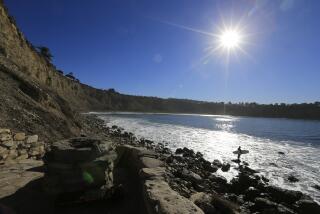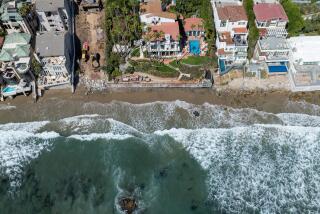Surf’s Up
- Share via
In the surfing world, Orange County rules. Its 42 miles of coastline boast some of the world’s best surfing, both the body and board varieties. It’s long been a magnet for surfers, competitions and organizations--including headquarters for the leading surf magazines and clothing companies. Here is a primer for the local surfing scene:
By the Boards
Blake Hollow: Lightweight hollow board invented in the 1920s by Tom Blake, surfing innovator in California and Hawaii. About 11 feet tall and 120 to 130 pounds.
Early Hawaiian: Alaia, usually made of wiliwili wood; about 9 feet tall and about 175 pounds.
Trestle Special: 1964
Thruster: Original 1980 design by Simon Anderson. About 6 1/2 feet tall and 8 to 10 pounds.
Modern: Late 1990s design. About 6 feet tall and 7-10 pounds.
Board Works
Although surfboard design is not an exact science, designers use many variations of shape and size to change performance. Another major development in the evolution of the surfboard was the addition of the fin, in 1935 by Tom Blake. Fins add stability and aid in maneuverability. The first leash was added in the ‘70s, the early ones being made of surgical tubing.
Wave Wonders
Cutback: This is a change of direction, back toward the breaking section of the wave. It’s usually a setup move. The idea is to end up in the same position on the wave as when the move began.
Floater: This can be a dangerous trip over the top of a breaking section of the wave. Surfer climbs to the top of the wave and then slides across the top of the tubed section.
Aerial: Similar to a maneuver skateboarders perform in a pool or bowl. Surfer turns hard off the bottom, accelerates up the face of the wave and blasts into the air, hoping to change direction while airborne.
Tubes: The tube is formed by the wave face and the lip, which cascades down like a curtain, hiding the surfer inside. Requires excellent timing, as surfer usually stalls the board and lets the breaking section of the wave catch up.
Surf Speak
Lip slash: A big power turn off the top of the breaking wave, or lip. Also called lip bash.
Shred: When the rider rips a wave nonstop, going from maneuver to maneuver, just shredding it.
Gouge: Rider shredding with such explosive power that he gouges the wave. Synonymous with Hawaiian power surfer Johnny Boy Gomes.
Tailslide: Rider shifts weight on his trail foot, pushes down and slides the tail of the board.
Wipeout: To fall or be knocked off board when wave overwhelms surfer’s skills.
Buried: Getting into the breaking wave so far inside the tube that surfer can’t be seen from shore. You’re buried behind the green wall of water. Also means you’re headed for hall of fame if it’s caught on video.
Sources: “Surfing, The Ultimate Pleasure,” “The History of Surfing,” “Surfing Fundamentals,” California Coastal Resource Guide, Surfing Magazine, Times reports; Researched by PAUL DUGINSKI / Los Angeles Times
More to Read
Sign up for The Wild
We’ll help you find the best places to hike, bike and run, as well as the perfect silent spots for meditation and yoga.
You may occasionally receive promotional content from the Los Angeles Times.






